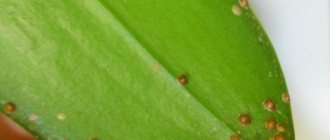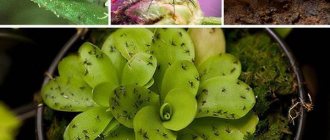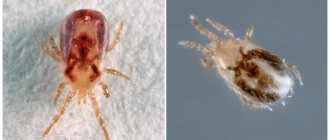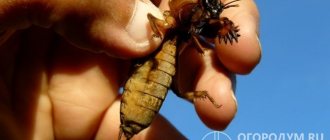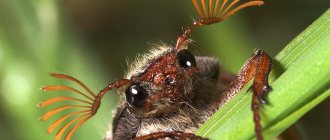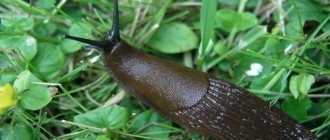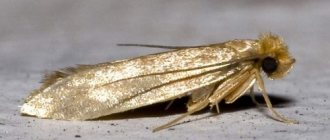Signs and causes of pests
Many cabbage pests are very small in size and live underground or inside cabbage heads. The presence of insects is most often reported by indirect signs:
- change in leaf color;
- deformation and twisting of plates;
- whitish, brown or black spots on cabbage;
- small and large holes on the leaves.
When damaged by insects, cabbage often slows down its development. The leaves of the seedlings turn pale and wither, the heads of cabbage become small and lose their juiciness.
Cabbage especially often suffers from pest attacks in warm and humid weather.
Several factors especially contribute to the appearance of pests in cabbage beds:
- chronic soil waterlogging;
- unharvested plant debris in beds in which parasites overwinter;
- a large number of weeds.
Pests often attack cabbage if agricultural practices are not followed. It is not recommended to plant the crop in areas where other cruciferous plants were previously located, since the likelihood of infection by parasites increases sharply.
Cabbage scoop
Dangerous pest of cabbage. It also damages beets, onions, peas, lettuce, poppy seeds, potatoes, beans and other plants.
The butterfly is brown-gray, with a wingspan reaching 50 mm. The front wings have two dark stripes and two spots of the same color. The eggs are hemispherical in shape, with radial ribs extending from the top. Adult caterpillars are greenish or brownish-brown, with wide yellow stripes on the sides, up to 50 mm long.
The cabbage cutworm develops in two generations per year. The pupae overwinter in the soil at a depth of 10–12 cm.
The flight of butterflies of the wintered generation takes place in the second half of May, of butterflies of the next generation - in August. Butterflies are nocturnal. During the day they sit under leaves, under lumps of soil. The dark color of butterflies makes them inconspicuous.
Females lay eggs on the underside of cabbage leaves in groups of 10 to 100 pieces. The egg stage lasts 5-10 days. The first time after hatching, the caterpillars live together - where the eggs were laid. They feed at night on the leaf parenchyma on its underside. The grown caterpillars crawl around the plant, hiding between the leaves. They gnaw through holes of various sizes and shapes in cabbage leaves. But more serious damage is caused by adult caterpillars. They penetrate the head of cabbage, gnaw long passages in it, and pollute it with excrement. The head of cabbage loses its marketable appearance. A species is an evolutionarily established set of individuals, characterized by a single... The development of caterpillars lasts about a month. Having finished feeding, they go into the soil to pupate.
The number of cutworms is reduced by Trichogramma, tachina flies, and parasitic ichneumon flies.
Control measures. Early planting of seedlings. Good care of plants, ensuring their normal development. Periodically inspect plants and crush caterpillars. Loosening the soil between the rows of cabbage and other crops, which causes the death of caterpillars and pupae in the soil and makes it difficult for butterflies to emerge. Weed control. Digging the soil after harvesting. Release of Trichogramma during the period of mass egg laying by butterflies. Spraying cabbage with Kinmiks against caterpillars before setting a head of cabbage.
Pests of cabbage in greenhouses and open ground
The juicy leaves of cabbage make it very attractive to harmful insects. Among the parasites, there are several of the most common.
Aphid
A small black or green insect attacks cabbage in large colonies. It is dangerous because it can completely destroy a head of cabbage in just a few days. Aphids can usually be seen with the naked eye. But even with a small number of insects, the condition of the leaves allows one to suspect their presence - the plates turn pink and curl.
Aphids often appear in the garden if there are ants in the garden
Slugs
In rainy weather, cabbage is threatened by slugs, which easily move onto the plant from the ground. Gastropods not only eat leaves, but also transmit viral and fungal diseases. During the day, slugs usually hide, but you can recognize their presence by wet slimy tracks and holes in the plates.
To prevent slugs, you can mulch the beds with rough material - it will make it difficult for pests to move
Medvedka
A dangerous garden pest feeds on the roots of cabbage and other vegetable crops. The mole cricket gnaws long passages underground and practically does not come to the surface, so it is difficult to get rid of it. To combat, you can use crushed eggshells. About 10 g of the product is moistened with vegetable oil and placed around the stem in a groove up to 4 cm deep.
Advice! In the fall, you can bury traps in the garden - basins and bowls with manure sprinkled with vegetable oil. In the spring, the containers are removed and the contents are burned along with the pests.
To prevent mole crickets, you can plant marigolds in the garden - their smell repels the pest
Thrips
Small thrips feed on plant sap and especially often harm Peking, white and Brussels sprouts. It is very difficult to detect them visually, but the presence of an insect is indicated by whitish spots on the leaves, which over time turn into necrotic areas. The pest usually attacks beds in hot and dry weather; the best preventative measure is regular, abundant watering.
Thrips often move to cabbage from eggplants and peppers
Cruciferous bugs
Large insects with red spots on the elytra are clearly visible on cabbage leaves. The pest feeds on the sap of the plant, the heads of cabbage stop developing, become deformed and die.
The most dangerous are the larvae, although the adult insect also causes damage to plantings. Since cruciferous bugs live directly on vegetable leaves, they can be controlled not only by spraying, but also by hand picking.
The cruciferous bug wakes up in mid-spring and leaves for the winter in August
Cabbage moth
A small grayish-brown butterfly lays eggs on cabbage leaves, from which colorless larvae hatch. Over time, the caterpillars acquire a light green or brown color. They actively eat the greenery of seedlings and damage the ovaries, and can completely destroy the crop.
Cabbage moth begins to cause damage from mid-April
Cabbage scoop
From mid-spring and throughout the summer, cabbage is damaged by the larvae of the nocturnal moth - cutworms. Caterpillars can be light yellow, brownish or brown, with longitudinal stripes on the sides. After hatching, they settle on the underside of leaves. They gnaw holes in cabbage plates and make tunnels in heads of cabbage.
The cutworm rarely attacks cabbage in large colonies, so it is quite easy to remove it with insecticides
Cruciferous flea beetle
Very small jumping insects feed on thin young cabbage leaves. The pest larvae damage the roots of the crop in the ground and prevent the development of heads of cabbage.
Although the parasite reaches only 3 mm in length, it is not difficult to notice it on the plant. The cruciferous flea beetle settles on cabbage in large colonies and literally pockmarks the tops with small holes. When you shake the leaves, you may notice black jumping bugs.
Cruciferous flea beetles become active at temperatures above 15 °C
Worst Enemies
Protecting cabbage from voracious pests is the main task of a vegetable grower, but for effective prevention and control, you need to learn more about them. Descriptions with photos characterizing insects will help you do this.
Let's look at the most common and dangerous ones:
Aphid
Sucks the juice out of the plant. It can quickly, within a few days, destroy a large head of cabbage. The insect is easy to notice visually or by the condition of the plant. The leaves change color, turn pink, then curl. In some cases, treatment with folk remedies helps destroy the pest. Aphids are active in greenhouses and in open ground and attack all varieties of cabbage.
Thrips
Very small insects, it is almost impossible to detect them with the naked eye. They affect the plant locally, whitish spots appear in places of accumulation, which then darken and die. They affect Brussels sprouts, Chinese cabbage and white cabbage, and can spread to decorative cabbage.
Cruciferous bugs
It is not difficult to identify them on the leaf blades of the plant. The insect is bright, rich green. There are red spots on the fenders. It is not necessary to use pesticides for control; pests can be collected manually and destroyed. Most often they come from uncultivated land, so you should fight weeds in your summer cottage.
Slugs
They often appear in conditions of high air humidity, they react painfully to high temperatures and sunlight, so during the day they hide in the leaves inside the head of cabbage. They are dangerous because they cause the development of diseases of fungal and viral etiology. Traps are used for destruction.
Caterpillars and butterflies
Damage to plantings is caused by the leaf beetle, white moth, cutworm, and common cabbage moth. Insects chew holes in the leaves and leave traces of their own excrement on them. It is impossible to collect insects by hand. They are destroyed with special chemicals.
Medvedka
Dangerous for all vegetable crops. It does not disdain cabbage, affecting its roots. The most effective control is achieved with proper organization of plantings. An eggshell, which is dangerous for the pest, is placed in each hole.
May beetle larvae
These cabbage pests are primarily dangerous to seedlings. Young white larvae are voracious and can destroy the entire root system. The plant looks stunted, withers or gradually dries out.
Fleas
Insects whose body reaches 3 mm in length. They are active in spring and summer, nibbling young and succulent leaves of seedlings, which then dry out and die. For prevention, any insecticidal preparations are used, the main thing is to use them in a timely manner.
Cabbage leaf beetle
A large green beetle that eats all varieties of cabbage. It reproduces quickly - the female produces several generations per season. The larvae are no less dangerous to cabbage than adult insects; they consume plant pulp. For effective destruction, you need to spray the beds with chemicals.
Cabbage flies (summer and spring). Small insects that destroy the root system, stems and heads of cabbage.
Attention! All of the insects listed are dangerous for cabbage, so you need to figure out how to deal with them. You can achieve good results by following the general recommendations regarding the products used.
How to save cabbage from pests without chemicals
Fighting cabbage pests with folk remedies is considered preferable. Treatments can be carried out at any stage of plant development, including during the formation of heads of cabbage. The harvest will not absorb harmful substances and will not lose nutritional value.
How to save cabbage from pests with vinegar
Treatment with a solution of table vinegar brings a good effect against pests. You need to add 150 ml of the product to 10 liters of water and mix thoroughly.
Spraying is carried out in dry weather in the evening every 3-4 days. It is especially convenient to control cabbage pests with vinegar shortly before harvest. The solution does not harm the formed heads of cabbage.
Advice! For spraying, you can use vinegar essence 70%, but in this case add only 15 ml of product per 10 liters of water.
Soap and ammonia solution
An ammonia-soap solution works well against aphids and other cabbage pests. To prepare it, you need to mix 100 ml of liquid soap and 60 ml of ammonia in 10 liters of water. Spraying is also carried out twice a week; evening time is chosen for processing.
Saline solution
Table salt can be used against pests of cabbage roots and cucumbers. Dilute 250 g of powder in 10 liters of water and stir until the grains are completely dissolved.
The salt composition is poured directly under the cabbage root. After this, it is recommended to sprinkle the soil with wood ash.
Saline solution is especially effective against cabbage flies because it destroys their eggs.
Dandelion solution
A video about how to save cabbage from pests using folk remedies recommends using dandelion infusion in combination with laundry soap.
The solution is prepared according to the following scheme:
- About six adult dandelions are crushed along with the root.
- Pour 10 liters of boiling water over the raw materials.
- Leave covered until completely cool.
- Strain the product and add a grated bar of laundry soap.
- Stir thoroughly until dissolved.
The resulting product is infused for another day, after which it is poured into a spray bottle and sprayed. Cabbage must be processed twice a week during the warm season.
Valerian decoction
Descriptions of cabbage pests with photographs include the use of valerian decoction in combination with tobacco among treatment methods. The spray preparation is made as follows:
- Pour 200 g of valerian root into 5 liters of water.
- Add 500 g of fresh tobacco leaves.
- Boil the raw material over low heat until it boils.
- Leave covered in a dark place for a day.
The finished composition is filtered and used for spraying twice a week. The infusion can also be used for watering the roots.
Mustard infusion
Mustard infusion works well against insect pests of cabbage. It is prepared like this:
- Pour 5 liters of water into 100 g of mustard powder.
- Mix and leave in a closed container for a day.
- After the period has passed, the infusion is topped up with clean water in a 1:1 ratio.
The treatment agent is poured into a sprayer and the heads of cabbage are sprayed twice a week. Particular attention is paid to the base of the plates, since butterfly caterpillars and other pests usually live there.
Attention! To make the mustard infusion stay on the leaves longer, you can add a little soap to the finished composition to increase the viscosity.
Pepper infusion
An infusion of red pepper helps to cope with aphids, caterpillars and midges. The recipe for preparing the product looks like this:
- Fresh pepper is crushed in the amount of 100 g.
- Pour in 1 liter of clean water.
- Boil over moderate heat for an hour.
- Dilute the resulting concentrate with a bucket of water.
- Leave to infuse for two days.
The product is used for spraying tops and heads of cabbage. The drug can be used both for prevention and for symptoms of pest infestation.
Toothpaste solution
An unusual method suggests using toothpaste to control pests. Add 100 g of product to 10 liters of water and stir until completely dissolved. As in all cases, spraying is performed 2-3 times a week after sunset.
To prepare a solution for pests, you need to use simple toothpaste, without additives or flavorings.
Ash decoction
A decoction of wood ash helps against aphids, slugs and other cabbage parasites. It repels insects and other pests, and also enriches the soil with nitrogen and stimulates the growth of heads of cabbage. The drug is made like this:
- Pour 300 g of wood ash into 1.5 liters of fresh boiling water.
- Boil the solution over medium heat for half an hour.
- Allow the product to cool slightly and filter off any sediment.
- Dilute the concentrated infusion with clean water to obtain 10 liters of the drug.
Cabbage plantings are sprayed with a spray bottle in the presence of insects and as a preventative measure 1-2 times a week. Wood ash can also be used in dry form to sprinkle the beds twice a month.
Cabbage moth
This pest lays eggs, from which larvae hatch after about a month. They are the most harmful to cabbage and other vegetable crops, as they eat everything. During the winter, these insect pests hide in the ground, which is why it is so important to carry out deep digging in the fall - in this case, the sleeping insects end up on the surface and freeze out.
In the central regions, up to 3 generations of this insect pest can appear during the summer season.
Photo of cabbage moth
For the purpose of prevention, in addition to autumn digging, crop rotation should be observed, and plants should be grown between rows that repel pests with their smell, including cabbage moths. You also need to remove all weeds, especially those from the cruciferous family.
Effective folk remedies and insecticides that help in the fight against this pest are the same as those used against other cabbage pests.
How to control cabbage pests using drugs
In case of severe pest infestation, cabbage beds can be treated with chemicals. They are usually used in spring and early summer before the heads of cabbage form, so as not to harm the crop.
Aktara
The drug has a good effect if the cabbage is attacked by caterpillars, beetles or large colonies of aphids. To make a solution for spraying, you need to dilute only 3 g of the finished powder in 10 liters of water.
Treatment is carried out in the evening in dry weather. To eliminate pests, the procedure is repeated weekly 4-5 times in a row. Aktara quickly penetrates cabbage leaves and is not washed off by rain.
Aktara's solution not only eliminates parasites, but also improves the germination of cabbage
Iskra-M
The Iskra-M product is used in case of invasion of aphids, whiteflies or mole crickets. The solution is prepared at the rate of 3 ml of the drug per 3 liters of water; it must be done immediately before the treatment. The beds should be sprayed 3-4 times during the growing season to eliminate adult pests and their larvae.
For 50 m2 of garden you need to prepare 5-7 liters of Iskra-M working solution
Kemifos
The universal drug Kemifos is intended to control pests of vegetable and fruit crops. The solution is prepared according to the same scheme - 10 ml of a chemical is diluted in 10 liters of water right before treatment.
Spraying is carried out at a temperature not exceeding 25 ° C on a dry, windless day, in the morning or after sunset. To treat 1 m2 of cabbage beds, only 120 ml of solution is enough.
Spraying with Kemifos is carried out at intervals of 18 days at least 2-3 times per season
Processing times
You can drive pests away from your garden beds or prevent their attacks with the right approach to the problem. In this case, the use of all methods is justified: biological, folk and chemical. Each method has different effectiveness.
Folk recipes and biological protection products are used when the problem first appears. In case of massive damage to seedlings or adult bushes, it is better to use chemicals. If you follow the basic rules, it is destructive to the pest and absolutely safe for the gardener.
Recommended timing of treatments with insecticidal and biological preparations:
- Early spring. Powerful insecticides are used, which are sprayed 2 weeks after planting young seedlings in open ground. The average daily temperature should be no higher than 14 degrees. Once the indicator exceeds this mark, the risk of rapid spread of cabbage and cruciferous flea beetles increases.
- Early - mid June. Treatment is carried out against the main pests of cabbage. Insecticides or broad-spectrum biological preparations are used.
- Consolidation of the result. Provided 10-14 days after the second treatment. The same remedy is used.
Attention! You can safely use chemicals until the head forms. The active substance will be completely released from the plant cells within 3 weeks, and the gardener will be able to enjoy the harvest.
Meeting deadlines is not enough. In order for the treatment to give full results - to destroy all pests and protect the cabbage from them later, you must follow these recommendations:
- choose cloudy and almost windless weather;
- study the forecast of weather forecasters and exclude rain during the day;
- add regular soap or shampoo to the solution prepared for treatment (so that the drops linger on the surface of the sheet longer);
- treat all plants (not just infected ones);
- Prepare the products used according to the instructions.
It is not recommended to exceed the doses specified by the manufacturer, because such actions may cause damage to the plant itself. It will not be possible to increase efficiency, but the gardener may well destroy the crop.
Chemicals
To treat cabbage against pests, “radical” chemistry is rarely used. This is due to the fact that it is more difficult to wash off the remaining drug from the soil and from the leaves of the head than in the case of other crops.
Most often, such treatments are carried out before the head of cabbage is formed - in the first month after planting the seedlings in open ground or a greenhouse. Then proceed with caution, choosing biological and traditional methods.
In spring, young shoots are treated with the following means:
- "Alatar";
- "Decis";
- "Aktara";
- "Spark";
- "Fury";
- "Bankol."
Attention! After the head is formed, treatment is provided by folk and mechanical methods. Insects are collected and destroyed, and then the plantings are treated with solutions that are safe for humans.
Traditional methods
Safe ingredients are used to prepare homemade insecticides. The solutions contain the following substances:
- tobacco;
- hot pepper;
- ammonia and vinegar;
- laundry and tar soap;
- roots and leaves of plants;
- mustard powder;
- table salt.
These repellents repel insects with their distinctive scent. They are completely safe for humans and plants, are not absorbed into the structure of the leaves, and do not change the taste of the vegetable. After use, the upper leaves may be slightly bitter, so they are advised to be removed. Repeated use is allowed.
Popular folk recipes that ensure the destruction of pests on cabbage:
- A solution of liquid soap and ammonia. Helps destroy aphids. Dissolve 100 ml of soap and 4 tbsp in 10 liters of water. ammonia. Mix the liquid and spray the beds.
- You can destroy the eggs of cabbage flies with a solution prepared from 250 g of salt and 10 liters of water. They water the plants separately in the holes, and then sprinkle the soil with wood ash.
- Spraying with vinegar solution. Helps in the fight against larvae and butterflies, protects against white moths and moths. Dilute 1 tbsp in 10 liters of water. vinegar essence. Mix and spray quickly, otherwise the active substance will evaporate.
- Treatment with a solution of dandelion and laundry soap. Together with the roots, 3-5 adult plants are pulled out, crushed and poured with boiling water. Leave until cooled, then add grated laundry soap (1 bar). Leave it for a day, and then spray the plants.
- Using a mixture of ash, soda and red pepper. Recipe in this video:
Attention! Prevent the rapid spread of insects. Inspect the cabbage in a timely manner and begin exterminating the pest immediately. If widespread, traditional methods may be ineffective. In this case, it is better to carry out treatments 3-4 times at intervals of 5 days.
Preventive measures
The success of pest control of white cabbage largely depends on quality prevention. To protect the plantings it is necessary:
- dig up the beds every autumn - this allows you to destroy the eggs and larvae of insects;
- regularly loosen the soil under the cabbage during the growing season;
- annually replant the crop to a new location and use herbs or beets as predecessors;
- maintain the distance between individual plants so as not to thicken the plantings;
- Regularly inspect cabbage for specific damage and other traces of pests.
It is recommended to plant a cold-resistant crop in open ground as early as April. In this case, by the time most insects awaken, the cabbage leaves will become tough and less attractive to pests.
Attention! To protect your plantings from parasites, you can plant fragrant coriander, cumin or calendula near the crop.
Cabbage pests: cruciferous flea beetle
Immediately after planting the seedlings in the garden bed, the cruciferous flea flea, which is almost unnoticeable but dangerous for cabbage, appears. The insect wakes up during the period when the soil warms up (March–April). The flea beetle settles on any grass, and with the appearance of sprouts or cabbage seedlings in the ground, it moves to its favorite crop.
How dangerous are small bugs jumping around the garden bed? Fleas:
- feed on plant sap;
- chew leaves to holes;
- destroy growth petals;
- inhibit the growth and development of the seedling, which leads to drying out of the ground part.
Cabbage pests: description and signs of parasitism
Cabbage is a juicy plant that is attractive to parasites. From the end of May, traces of ground-air insects may appear on the seedlings: curled, limp leaves, spots, holes. Also, some soil pests feed on the roots, which leads to the rapid death of the crop. In order to identify the problem in a timely manner and prevent crop loss, the gardener should be aware of the signs of attack by aphids, cabbage grass, caterpillars and other representatives of fauna.
Owl and white owl
At the beginning of May, beautiful butterflies begin to appear in cabbage beds, which can significantly reduce the yield. The cutworm is a nocturnal insect that has brown or gray wings. The pest attacks the upper part of the cabbage, laying eggs on the leaves. Hatched caterpillars, eating the upper and lower parts of the plant, can destroy several bushes in a couple of days.
Expert opinion
Stanislav Pavlovich
Gardener with 17 years of experience and our expert
Ask a Question
This is interesting: cutworm caterpillars eat the base of seedlings at night. During the day they hide underground, while pulling the lower leaves of the cabbage with them. By this sign you can determine the presence of a pest in the garden.
The white butterfly is a small daytime butterfly with white wings. The insect lays eggs on the underside of a cabbage leaf. Voracious caterpillars emerge from the clutches and eat the soft parts of the cabbage. Signs of parasitism: the appearance of a leaf skeleton, black excrement on heads of cabbage.
Slugs and snails
Slugs and snails live in damp, dark places. These are polyphagous pests; they eat roots, trunks, leaves, and seeds of vegetable crops. The appearance of parasites is always accompanied by the presence of holes of different sizes in cabbage leaves. Also during the day you can see traces of their movement and activity. The part of the plant on which mucilage is present does not receive enough sun and moisture, which leads to wilting.
Cabbage fly
The cabbage fly has a dark gray body color and reaches 5-7 mm in length. The attack takes place in mid-May, when the seedlings are planted, and then in June, when the cabbage begins to grow. The insect lays eggs on the petioles, the hatched larvae begin to eat the pulp of the leaves and heads of cabbage. Externally, an infected crop looks like it requires watering: the leaves wither, turn yellow, and droop to the ground.
Aphid
An aphid is an insect that reaches 0.5 mm in length; the color of the body can be gray, white or greenish. The insect multiplies very quickly and spreads throughout the entire garden bed. The main sign of damage is leaf curling, wilting, the appearance of gray-yellow spots, and a whitish coating (the result of the vital activity of the parasite).
Expert opinion
Stanislav Pavlovich
Gardener with 17 years of experience and our expert
Ask a Question
This is interesting: ants are very fond of the sweet-sticky secretions of aphids, which appear in the process of their life. Therefore, ants bring parasites to the cabbage, where they graze them.
Cabbage flea beetles
Cabbage flea beetles are very small parasites that move quickly and jump high from bed to bed. After they appear, small holes are visible on the cabbage, the seedlings begin to wither, the leaves turn yellow and fall off. The pest larvae feed on the roots of the crop, which reduces the yield and prevents the development of large heads of cabbage.
Stem proboscis
The secretive proboscis, or weevil, has a gray or black body and a characteristic rostrum. The pest gnaws through cabbage stalks, makes its way inside the stems, and feeds on the insides of the plant. Signs of damage are slow growth, absence of ovaries, and leaf fall.
Cruciferous bug
The cruciferous bug, or variegated stink bug, has a bright red or yellow color, a flat body, and a developed shield. The insect is very prolific and can produce up to 350 eggs in one season. The larvae eat the succulent foliage, climb into the heads of cabbage, and the adult parasites suck out all the moisture from the seedlings. The appearance of the motley shield occurs in June - July. Signs of damage include wilting, curling of leaves, and decreased growth of the crop.
Caterpillars and worms
Most often, cabbage is affected by green caterpillars that emerge from cabbage eggs or butterflies. There are also small worms on the leaves, after which small stripes, yellow or gray spots are noticeable. Wireworm larvae (yellow-orange) attract starlings and rooks to the cabbage bed. Birds damage the heads and leaves of the plant.
Important: if white worms eat cabbage at the roots, cabbage fly eggs have been laid. In order not to lose the harvest, parasites should be urgently removed manually or sprayed with special preparations.
Medvedka
The mole cricket is a large insect (up to 5 cm long) of a dark brown color. The parasite destroys beds with cabbage, potatoes, tomatoes, and peppers at high speed. The pest eats the seedlings at the roots, which leads to the death of the crop. The larva living in the soil eats up the roots as it grows. As a result, the plant becomes lethargic, stunted, and has spreading, curled leaves.
Cabbage leaf beetle
The cabbage leaf beetle, or cabbage leaf beetle, is the most voracious parasite that can destroy a crop in just 3-4 days. It looks like a small dark green bug. Pests eat the succulent part of the foliage and then lay eggs inside. The larvae that hatch after 8-12 days skeletonize the cabbage.
See also Chinese cabbage: cultivation and care in open ground
Expert opinion
Stanislav Pavlovich
Gardener with 17 years of experience and our expert
Ask a Question
This is interesting: if a beetle gets scared, it pretends to be dead and lies motionless on its back. This feature allows you to get rid of the pest without the use of insecticides - if you simply lay something under the seedlings and shake them.
Dark nutcracker
The dark click beetle looks like a small beetle with a dark brown, convex body. Adults feed on cabbage leaves and stems and then lay eggs in the soil. The larvae of the parasite eat the plant from the roots, so it is not possible to immediately notice the worm. When a garden bed is infested with wireworms, a change in the color of the crop, wilting of the lower leaves, and the appearance of small holes on the head of cabbage are observed.
Hares
Hares appear in areas located near plantings and forests. The pest goes hunting early in the morning or at sunset. The animal eats the crop quickly, and can tear out the cabbage along with the stalk or destroy only the juicy head.
How to protect cabbage from hares in the country?
Hares are capable of destroying most of the crop in a few days. To protect your garden beds from the fluffy pest, you don’t have to watch the area all night. A high, strong fence will help preserve all the trees and plants. If it is not possible to build a fence, it is recommended to throw thorny branches of rose hips or roses along the area. Tar will also help save cabbage; the thief does not like its smell. It is necessary to lubricate the boards with it and place them between the seedlings.
Important: some summer residents advise making a trap or a noose. But interfering with the hare population by exterminating them is not humane.
